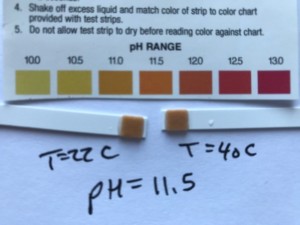Customer questions are the best because they come from real-world applications and actual experiences using our products. Here’s the question and answer of the day:
“We are performing a washout procedure. Samples of the wash are being tested with pH 10-13 test strips. Will the results of the test strip be affected by the temperature of the wash?”
The easy answer to this is no. Temperature does not affect the color developed by the test strip. But you know we never stop at the easy answer. And you wouldn’t be satisfied if we did. So, here goes…
We conducted an experiment to try and replicate their procedure.
- A buffer solution was prepared, measuring at pH 11.5 at room temperature (22°C).
- We tested this solution with a current lot of our pH 10-13 test strips.
- We then split the buffer solution sample into two parts.
- Solution A was kept at 22°C.
- Solution B was heated on a hot plate under rapid stirring.
- We then tested Solution B as it heated up, simultaneously testing solution A. We tested the warmed buffer Solution B at temperatures of 25°C, 30°C, 40°C, 50°C and 60°C, and solution A at room temperature.
- At the higher temperatures, we also recorded the pH of the warmed Solution B using a pH probe/meter equipped with temperature compensation.
The Results:
- The color of the pH 10-13 test pad did not seem to be influenced by the temperature.
- The pH as measured by the meter did progressively lower as the temperature was raised. At room temperature, 22°C, the pH measured 11.5. The pH consecutively dropped as temperature increased.
- 40°C – pH 11.2
- 50°C – pH 10.9
- 60°C – pH 10.6
 The test strip acted as we might expect a meter without temperature compensation to act – no effect. However, it is well established that “true pH” lowers as temperature increases. The results using the meter with temperature compensation confirmed this. This could present a challenge for a user looking to compare results with a test strip to a temperature compensated pH meter.
The test strip acted as we might expect a meter without temperature compensation to act – no effect. However, it is well established that “true pH” lowers as temperature increases. The results using the meter with temperature compensation confirmed this. This could present a challenge for a user looking to compare results with a test strip to a temperature compensated pH meter.
Therefore, if the customer is getting varied results from the pH test strips, it is likely due to the composition of the wash, not the temperature.
This is true for all of our pH test strips, not the pH 10-13. Our pH color charts were developed using NIST-traceable pH buffers at 25°C.
Colorimetric pH test strips do not offer “temperature compensation”. Care should be used when comparing results using test strips to those obtained with a temperature compensated pH meter.
It is well established that the “true pH” of a solution will be influenced by temperature. The extent of the effect is specific to the solution being tested. It is good practice when expressing results of pH testing that the temperature of the solution be recorded as well. In the case of test strips, since they do not compensate for temperature, it is recommended that the sample being tested be brought to room temperature first.







Leave A Comment